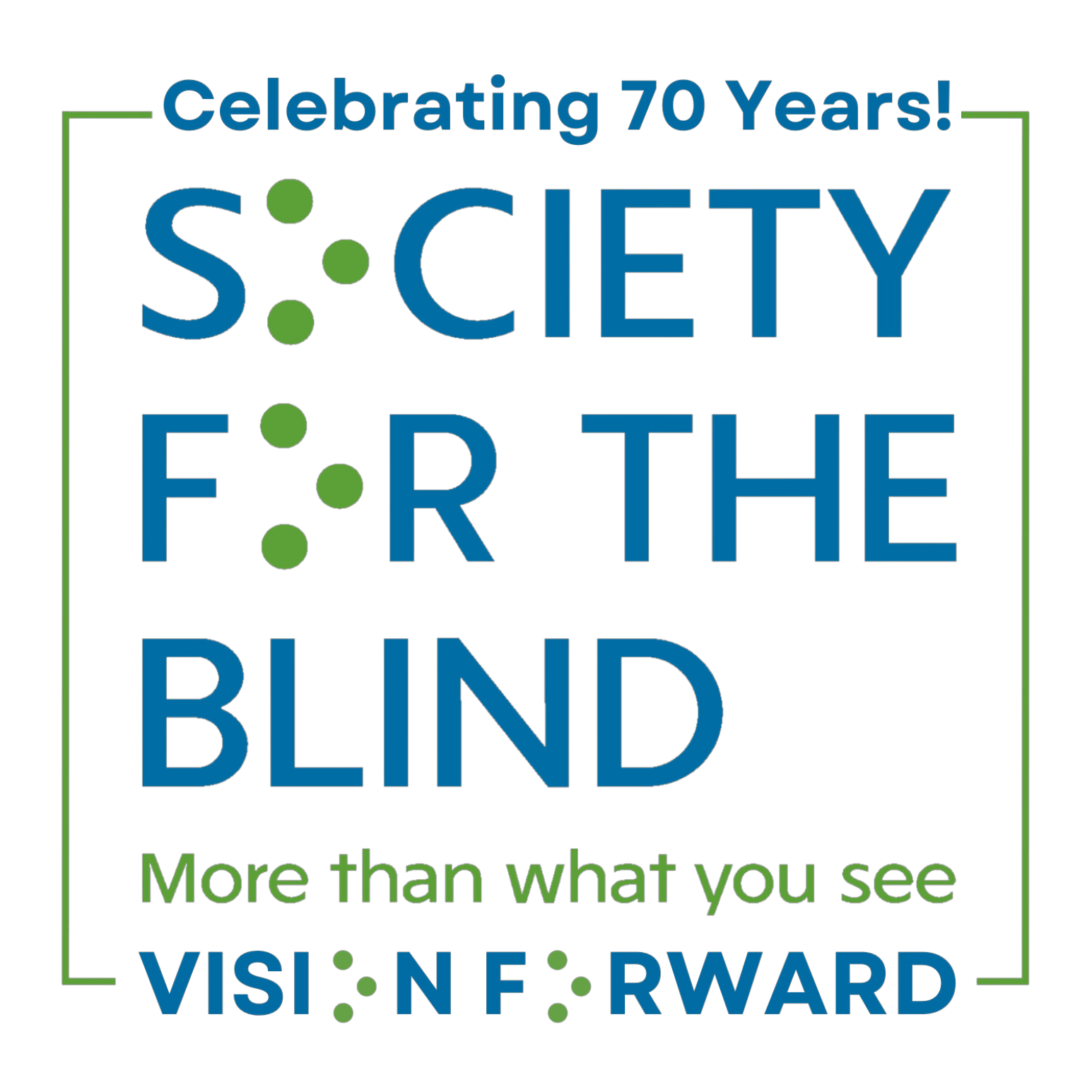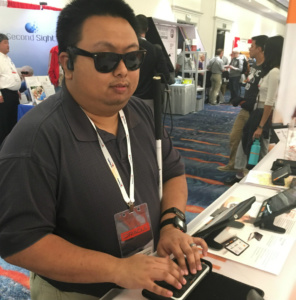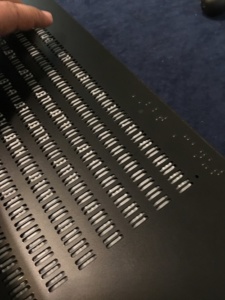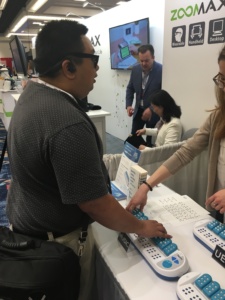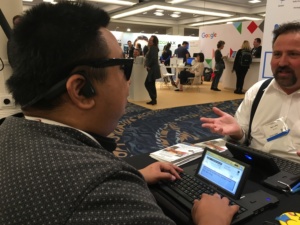Aser Goes to CSUN
By Aser Tolentino, Assistive Technology Instructor
Many years ago, stakeholders in the assistive technology industry began to gather at an annual conference hosted by California State University Northridge. Though the gathering has since far outgrown its humble beginnings, the conference is still hosted by the Center on Disabilities at CSUN, in downtown San Diego. There, at the end of winter, professionals working with all manner of disabilities— whether as educators, technology manufacturers, vendors, or in-house experts—engage in a week of workshops, networking and ogling the latest products for improving the lives of people with disabilities. This year, I was able to attend as Society for the Blind’s representative to check out what’s new and noteworthy in the world of assistive technology.
On stepping into the exhibit hall at CSUN, it quickly became clear that the assistive technology industry remains a vital and innovative space full of interesting ideas. Part of this dynamism comes from the sheer variety of new ways to challenge conceptions of what a person with a disability can and can’t do. Perhaps the most surprising and encouraging development along these lines was the number of inventors who came to the show with ideas that were intended to bring more affordable tools to a wider audience. Nowhere was this more evident than in advances in the world of refreshable Braille.
Historically, refreshable Braille displays have been the preserve of blind professionals or those working toward a career spent in front of a computer. This was due to the immense expense required to produce refreshable Braille cells, which are little technological marvels that can dynamically use pins to reproduce any Braille character in fractions of a second. A full line Braille display easily costs in excess of $2,500, and some models go for even higher. This has meant that most blind or visually impaired people have had to rely on bulky Braille books–or simply go without.
However, the American Printing House for the Blind (APH), and a company called Innovision, have both developed 20-cell Braille displays that cost about $500, which is less than half the cost of displays from established manufacturers with fewer Braille cells. This is accomplished using novel technologies that forego the traditional approach to refreshable Braille cells. In the picture below, you can see the Innovision display, which uses magnetically actuated pins to reproduce Braille characters. This method produces firmer dots that do not flex, as can occur with standard refreshable cells. This display will hopefully be shipping in the summer, at about the time APH is able to deliver more shipments of its Orbit Reader 20.
Of course, on the other end of the spectrum are companies pushing the envelope on what kinds of things a blind person can do with a Braille display. Nowhere was this more evident than at HIMS, where their new Braille Sense Polaris Mini was unveiled with an expected June ship date. The Polaris Mini costs significantly more than Innovision or APH’s displays, but that is due to the fact that it is far more than a simple display. The Polaris is the latest in a class of device known as a notetaker. Long before most people had heard of PDAs, visually impaired students were using small computers with Braille keyboards to take notes in class. The very first of these devices spoke the text as it was typed and could read it back on command. Eventually, they were coupled with Braille displays. The Mini has a built-in 20-cell display, but it also has an eight-core processor, three gigabytes of memory and a custom variant of the Android operating system. It is a fully functional, Google-certified Android device and can run any app from the Google Play store. Geared toward professionals and educational institutions, this device isn’t likely one you’ll see a lot in the wild, even if you work with a fair number of visually impaired people.
Also walking the halls at CSUN were teams working on rethinking what a refreshable tactile display looks like. Orbit Research and APH, the people behind the Orbit Reader 20, excited many attendees with their Graphiti tablet, a touch-sensitive device with over 4500 pins that could transform any visual image into a tactile representation, with graduated height to represent variations in color or brightness. With this display, a user could input an image and feel the contours of whatever sighted colleagues were seeing on the screen. Using touch gestures, they could scroll, pan, zoom, or even draw on the image. This could be useful for explaining visual or special concepts and relationships, graphing mathematical content or even performing cognitive diagnostics. Attendees were also informed that the Graphiti would be made compatible with the Canute Braille Display.
The Canute brought attendees yet another way of rethinking refreshable Braille. Rather than using electrical current to raise or lower a pin, the Canute consists of 720 octagonal rotors, each responsible for representing half of a Braille cell. With three dots that can either be raised or lowered in each half cell, this means eight possible permutations. When text is loaded into the Canute, the rotors spin to present the correct half of each cell. This takes some time, but the trick is that a reader will have that time, since the Canute displays nine lines of Braille at the same time. Moreover, it aims to do this with a retail price equivalent to what most companies charge for single line Braille displays. Graphiti integration may eventually lead to a scenario where a blind child reads about an image on the Canute then reaches over to the Graphiti to feel what it looks like. It is not an exaggeration to say that these two devices could literally change the way blind children learn.
Of course, for the time being there is still a need to teach children and adults how to read Braille and do math in the here and now. The Taptilo, pictured to the left, is one way of doing that. Using a smartphone app, a teacher or parent can input a word into the board’s refreshable Braille display that the student then duplicates using the oversized Braille cells along the top. It turns learning Braille into a game, one a sighted person can oversee even if they don’t know Braille themselves. On the lower tech end of things, the picture to the right shows Thinkable’s TactiPad, which can be used to draw tactile graphics onto a sheet of foil using a pen.
Tools for learning to use Braille music and for working with math and science were also on offer. This included historical staples like the Dancing Dots software that can teach students how to learn Braille music and can even be used to compose musical Braille. Pearson Learning, maker of educational software, was also on hand to demonstrate their new Braille equation editor. And of course, the makers of screen reader and screen access software were on hand to demonstrate their products.
This doesn’t even begin to touch on the accessibility features demonstrated day and night by companies like Adobe, Google, Microsoft and Amazon, Braille printers (that can now print directly from your phone), video magnifiers (many that you wear instead of glasses) and other traditional assistive technology tools on display. I also haven’t talked about the three days of workshops and presentations I attended, including one on the Instant Pot, but I hope I have given you a glimpse of all the wonderful work being done by dedicated, creative and very bright people around the world to make the lives of people with all kinds of disabilities fuller and better. I can’t wait to go back and see what they will come up with next.
